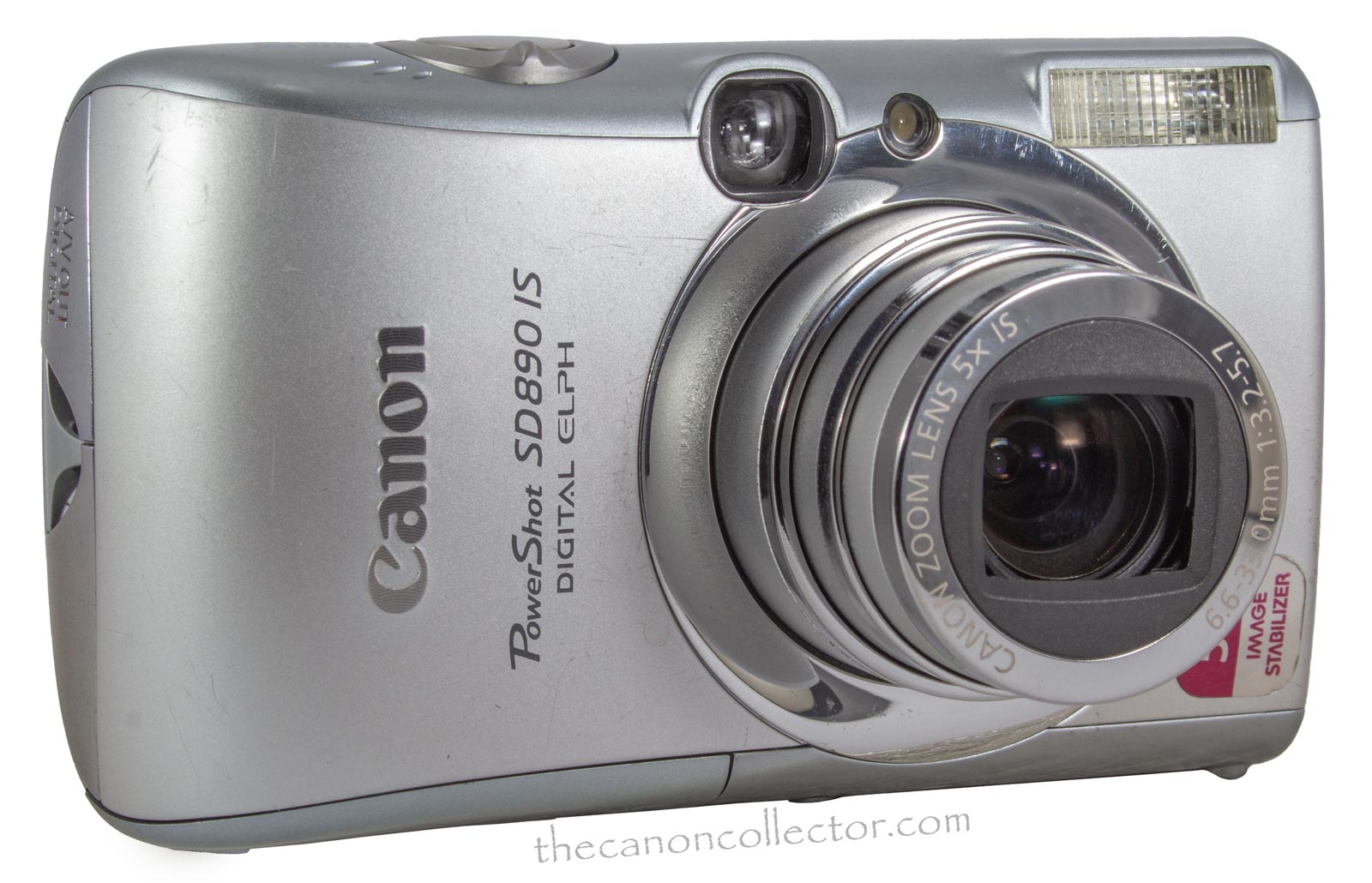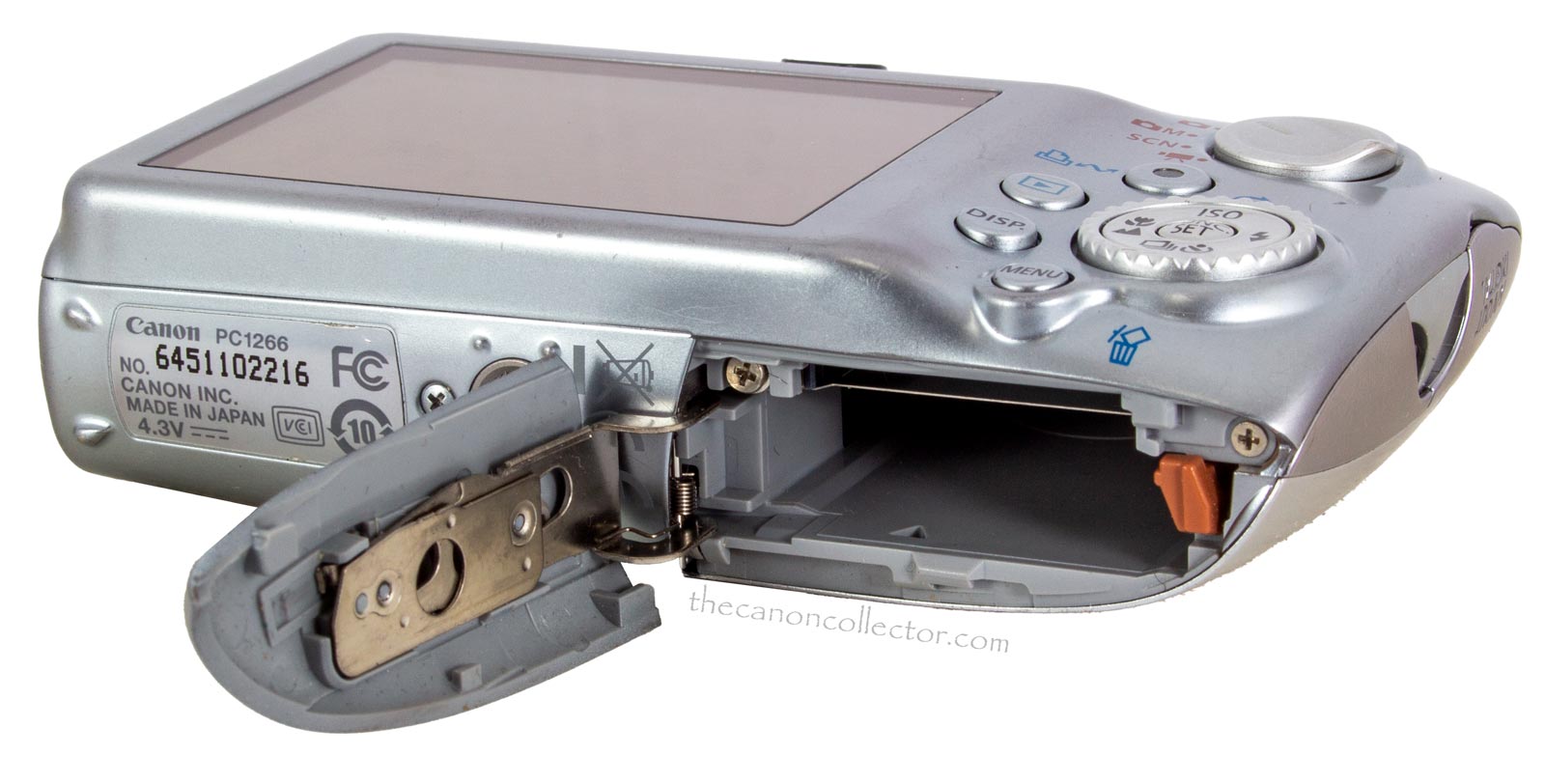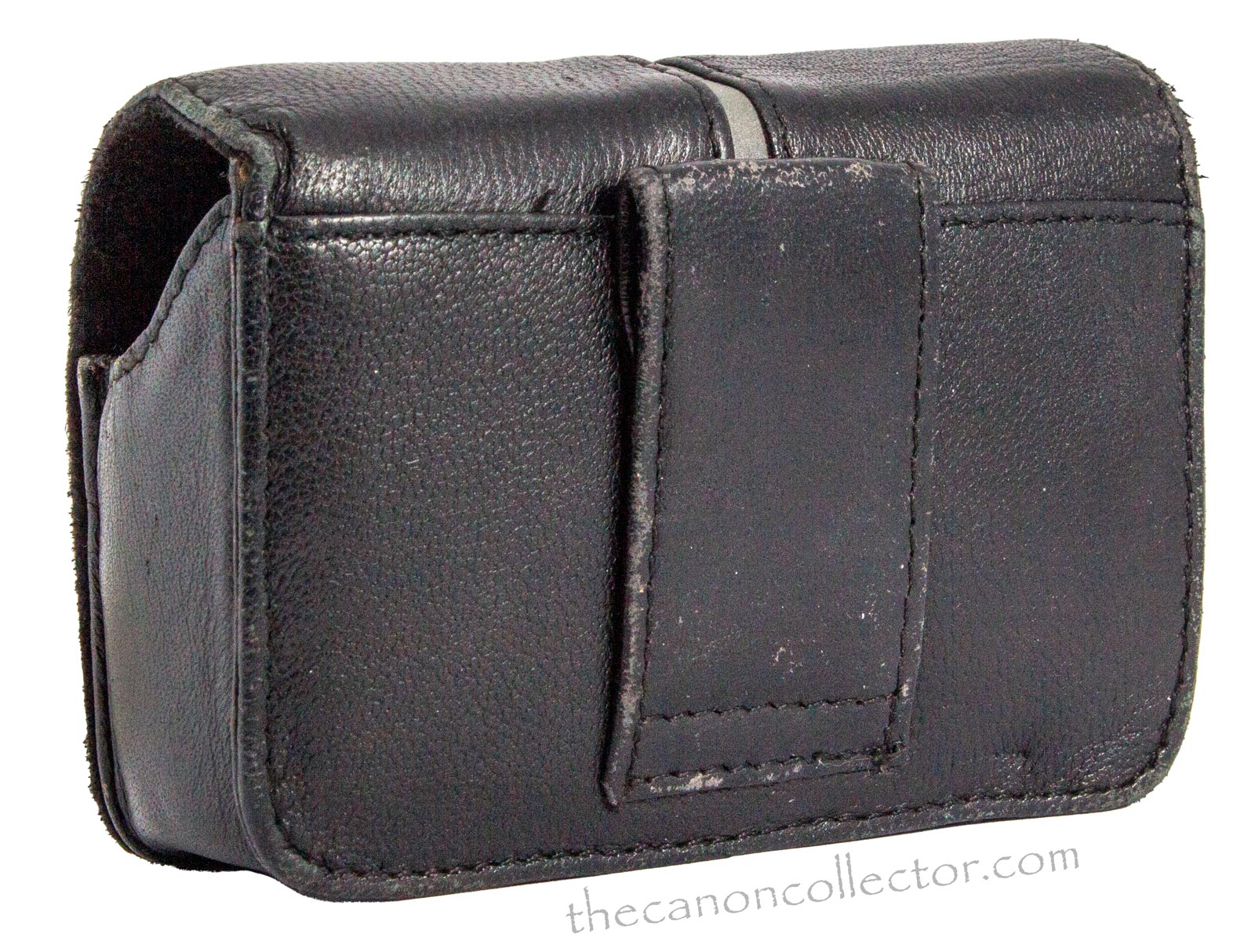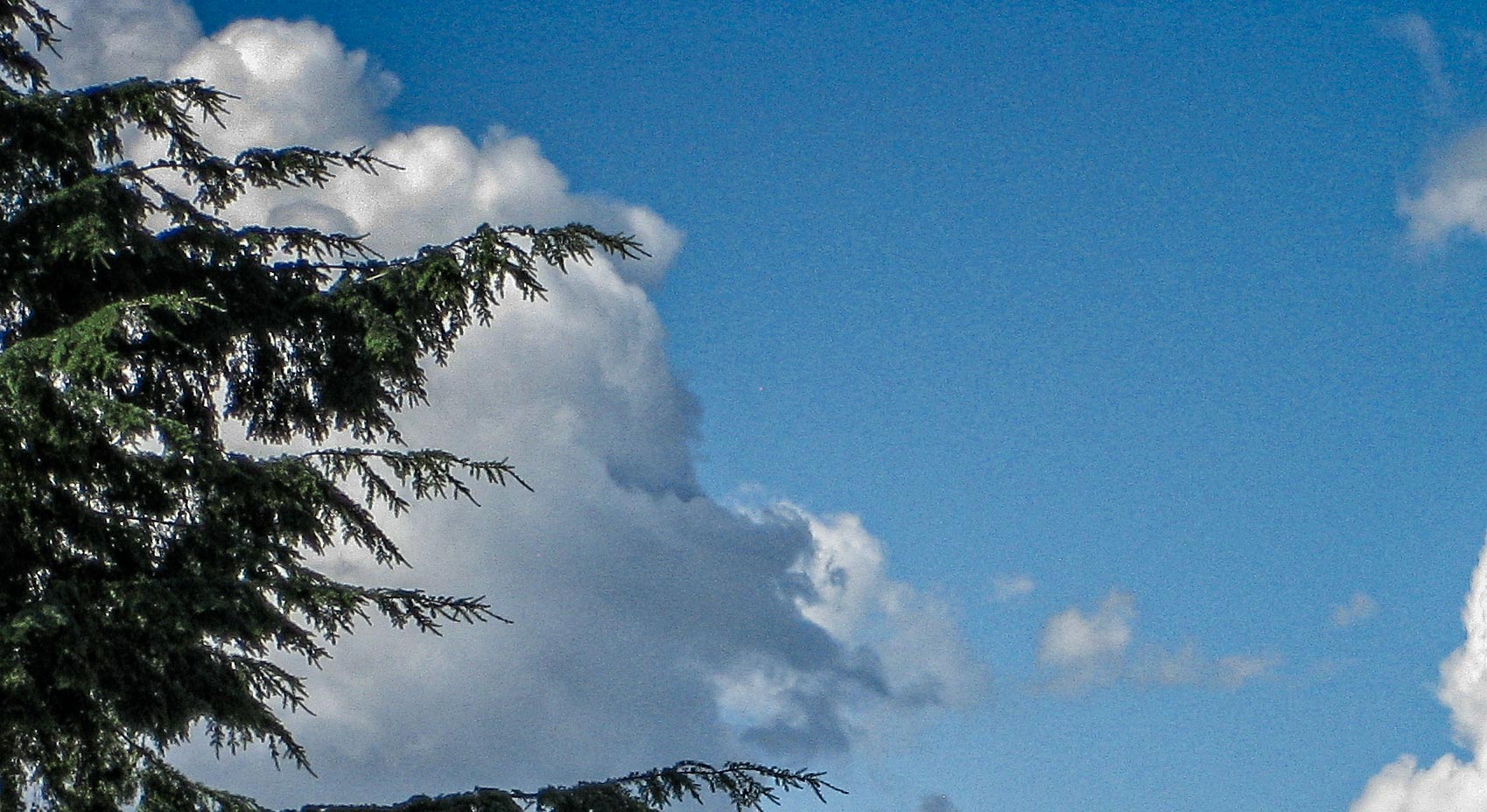PowerShot SD890 IS Digital Elph
This is my PowerShot Elph SD890 IS Digital Elph (Ser. No. 6451102216). When acquired it came in the leather case shown which allows it to be carried on the belt. There was no battery or charger but I was able to supply those.
The first Digital Elph was introduced in May of 2000 and the whole series has been noted for compact size and advanced automatic features. The SD890 continues in that vein.
This camera is known in Japan as
the IXY Digital 820 IS and in Europe
as the Digital IXUS 970 IS.
Introduced in April of 2008 it is a
fully automatic 10 mpx camera
with a 5x optical zoom lens.
The digital zoom adds a factor
of 4x a total zoom range of 20x.
The lens is a 6.6 to 33.0mm zoom range which works out to about
37 to 185mm in full frame equivalent terms. (I tend to ignore digital zoom
as it seems to me to be cheating. I can enlarge in post if I want to.) Aperture ranges from f/3.2 to f/5.9
Under normal circumstances the nearest focusing distance is 1.6 meters however there is a macro mode which allows focusing down to as close as 2cm. So, all in all, the lens makes for a very versatile camera.
Sensor speed is selected automatically in one of three modes, Evaluative, Center Weighted or Spot. Available speeds range from ISO 80 to 1600 but these cameras are subject to a lot of image noise at the higher values.
This is a very small camera. The lens tucks away when it is not in use making it about 2.5cm thick. It has rounded corners so it slips easily into a shirt pocket and the small leather case that came with it is such a small package on the belt that you virtually do not feel it. This is a great walkabout camera.
We have a Newsletter
There is a Newsletter for thecanoncollector.com to keep you up to date on what we are posting. Try it!
The layout of the SD890 will be familiar to anyone who uses any of
Canon’s compact cameras. The layout is intuitive and the menus are simple
enough to figure out with little trouble. A cover on the right side hides a mini-USB port.
The top and bottom of the SD890 have a simple and uncluterd layout and the rounded curved design is apparent. The bottom of the camera has the door to the battery and SD card compartment. The top is essentially the shutter button and zoom control only.
Focus is automatic 9 point TTL and it is smooth and quick although it is not great in low light or low contrast situations. The camera also has a rudimentary face detect feature which helps the camera focus on people in the scene.
Image stabilization is of the “moving lens” type and is really quite impressive. IS is engaged only when the shutter button is depressed half way but it can be set to continuous and there is a panning mode which only corrects for vertical camera movement.
This camera has a mechanical 2 curtain shutter as well as an electronic shutter. The electronic shutter allows for faster shutter speeds, increased maximum shooting rate, less vibration and absolutely no sound. Shutter speeds are selected automatically from 15 seconds to as short as 1/1600th.
The NB-5L battery and SD or SDHC memory card are loaded from the bottom. There is no separte time/date battery.
The camera is powered by the 3.7 volt 1120 mAh Canon NB-5L battery which uses the CB-2LX charger.
Images are recorded on SD or SDHC cards. Both battery and memory card load in the compartment accessed from the bottom of the camera. There is no separate time/date battery.
And that is our look at the SD890. A proper more complete review can be found on the Web and specs can be found in the Canon Museum. Detailed operating instructions can be found in the User Instructions.
This is the case and lanyard that came with my camera. It is really soft quality leather. It makes carrying the camera a breeze.
Well, that’s great, but how does it shoot?
So now we get down to it: can this camera take good pictures? Sometimes we forget that this exarcise is all about taking good pictures and being convenient and being reliable. There are no bad cameras. There are only cameras chosen for the wrong purpose. Bearing that in mind, where does this camera fit in and shine?
So let’s have a look at this image. If you stand on my front porch and look north, this is what you see. This is the full frame, all 3648 by 2736 pixels. The camera chose 1/500th at f/5.0 at an ISO of 100. The lens was zoomed to 23.74mm which is towards the middle of the 6.6 to 33mm range. The camera is automatic: there are no manual settings. I have touched up the contrast, sharpness and saturation in Photoshop but I have not edited the file. The powerlines are left right where BC Hydro put them.
Other than it is a great place to live, the picture is pretty pedestrian. It is a snapshot. But then that is what this camera was designed for: snapshots. Let’s have a look at this picture.
This is the center of the image at 100%. All things considered it is pretty good. The trees on the mountain in the distance are actually reasonably sharp.
I would say we have passed the first test. This is a pretty good image for a camera that literally fits in the palm of my hand and has no manual controls. So let’s look at another one.
Again, this is the full frame. No sharpening. I have adjusted only the contrast and brightness. The camera chose 1/500th at f/4.0 and an ISO of 125.
So I am happy that this camera can take a great picture. It is small, easy to carry, takes better pictures than it should. So that brings up the really tough question: can it take a better picture than my Samsung Galaxy 8?
The Galaxy 8 was introduced in April of 2017. It has a 12 mpx camera fixed at f/1.7 (at least I don’t think it has an automatic diaphragm). The focal length is fixed at around 26mm (equivalent in a full frame camera). So comparison is a little difficult. However, ignoring that, I took a picture with my cell phone and then with my SD890 while standing in the same spot. I tried to set the zoom on the camera to give me a corresponding image. The two pictures are below.
This full frame image from the SD890 was taken at 6.6mm (about 37mm) which is the widest zoom setting. The camera set 1/160th at f/3.2, ISO 80. 3648 x 2736 pixels.
The cell phone has the wider lens. That is the first thing that is obvious. And the image has a very different aspect ratio dictated, I suspect, by the shape of the phone. You want the image to fill the phone’s screen for maximum impact. And it does have impact!
When you zoom into the center, to 100% magnification, the image sharpness for both is excellent. And when you look at the upper left corner in both, the cell phone seems to have the edge. I did not expect that.
When you look at these images you know why cell phones have had such an impact on camera sales. If your goal is simply “snapshots” it is pretty hard to argue against the cellphone. It takes a picture that is as good as the dedicated camera. And this is an older phone. The latest phones have, I understand, significantly better cameras. And you can surf the web, check e-mail, view maps, etc. etc, and even make phone calls.
So, in saying that I like this camera, it is with the caveat that the cell phone is the better option for anyone who just wants to have pictures of vacations, days at the beach or the family cat. The SD890 is for the person who wants some control over the picture taking process, who wants to be able to zoom into the scene, who wants to be able to store images on a removeable chip.
This is not a rigorous review. I have not touched on video, for instance, or many other features. But you can see that where still photography is concerned, the SD890 is a great camera, but so is the Samsung Galaxy 8.
This website is the work of R. Flynn Marr who is solely responsible for its contents which are subject to his claim of copyright. User Manuals, Brochures and Advertising Materials of Canon and other manufacturers available on this site are subject to the copyright claims and are the property of Canon and other manufacturers and they are offered here for personal use only.






















